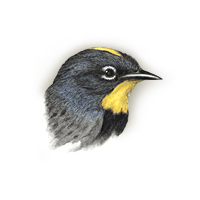 |
Yellow-rumped Warbler
Setophaga coronata |
|
|
STANFORD LOCATIONS: Common migrant and winter resident in various habitat types throughout campus. Densities may be quite high at flowering eucalyptus trees. [Breeding males have a black bib.] |
 |
Location |
Type |
Mating System |
Parental Care |
2ndary Diet |
Strategy |
|
|
|
|
I: 12-13 DAYS ALTRICIAL |
|
|
|
|
|
(3-5) MONOG |
MF(?) |
|
HOVER & GLEAN |
| BREEDING: | Conif and conif-decid forests. Often 2 broods. |
| DISPLAYS: | Courting male follows female, fluffs side feathers, raises wings, erects crown feathers, calls, and flutters. |
| NEST: | Usu on horizontal branch; of shredded bark, weed stalks, twigs, rootlets, some lined with feathers interwoven so tips curve over and screen eggs, other linings including hair. |
| EGGS: | White to creamy, marked with browns, grays, occ wreathed. 0.7" (18 mm). |
| DIET: | Tends to be more insectivorous in w than in e; berries of shrubs, esp in winter. |
| CONSERVATION: | Some sedentary in winter, some s to C.A. Common (e) or rare (w) cowbird host; female may destroy cowbird eggs by burying in base of nest. |
| NOTES: | One of the most generalized and opportunistic of all our insectivorous birds. Gregarious, often assoc in flocks. Males tend to forage higher than females. May skim swallow-like over water eating insects from surface. One of last warblers to migrate. Most abundant wood warbler in Canada. Occ roost communally in winter. Until recently, e and w populations were considered separate species, Myrtle (e) and Audubon's (w) Warblers. |
| ESSAYS: | Taxonomy and Nomenclature; MacArthur's Warblers; Migration; Bird Guilds; Species and Speciation; Cowbirds. |
| REFERENCES: | Harrison, 1984; Morse, 1980. |
| Help | Abbreviations | Species-Alphabetical | Species-Taxonomic | Essays-Alphabetical | |
| Except for Stanford Locations, the material in this species treatment is taken, with permission, from The Birder's Handbook (Paul Ehrlich, David Dobkin, & Darryl Wheye, Simon & Schuster, NY. 1988). | |||||